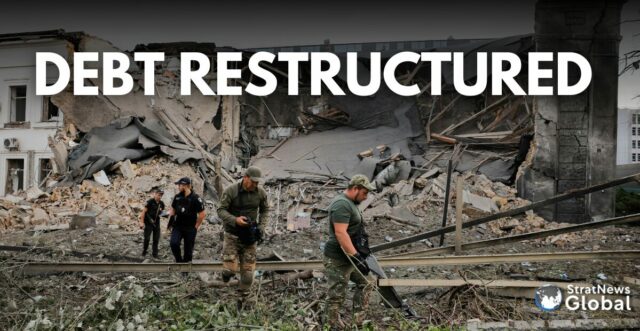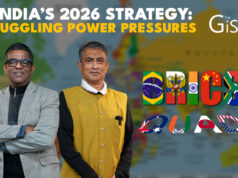A few months after Russia invaded Ukraine, Rothschild & Co handed Kyiv’s debt chief a critical black folder. It detailed major sovereign debt restructurings from the past 30 years.
For Yuriy Butsa, 40, the folder became essential reading. He hadn’t been involved in Ukraine’s 2015 debt restructuring after Russia annexed Crimea. Soon, he would need to use the restructuring expertise.
Economic Crisis
With the war crippling the economy, Ukraine agreed to pause bond payments by August 2022. Last week, the nation completed one of the fastest and largest debt restructurings in history.
Eclipsed in scale only by Argentina and Greece, the restructuring covers more than $20 billion in debt. It will save Kyiv $11.4 billion over the next three years. This is crucial for both the ongoing war effort and the International Monetary Fund programme.
“A stable situation where no more question marks are out there can only benefit Ukraine,” Arvid Tuerkner, managing director for Ukraine and Moldova at the European Bank for Reconstruction and Development, one of Kyiv’s big multilateral partners, told Reuters.
This account of how Ukraine’s agreement with bondholders came together is based on interviews with five sources on both government and investor side who were involved in the talks and agreed to speak with Reuters on the condition of anonymity.
Reviving Talks
Initial negotiations between the government and its lenders hadn’t gone to plan.
Talks in June had broken down after a couple of weeks with the core committee of bondholders complaining that the writedown Ukraine was demanding was “significantly in excess” of the 20% most had expected and risked doing “substantial damage” to relations.
High-Stakes Negotiation
With less than two months till the August 2022 payment moratorium expired, Rothschild arranged face-to-face meetings at the firm’s elegant Parisian offices on the leafy Avenue de Messine.
Rothschild declined to comment. The IMF did not immediately respond to a request for comment when asked on a U.S. holiday.
Early on July 16, representatives of some of the world’s top asset management firms and their legal and financial advisers arrived in Paris. Here, they joined Butsa, Ukraine’s long-term legal advisers White & Case and the Rothschild team.
A raft of meeting rooms had been reserved to allow for joint discussions and private strategizing.
The mood was pragmatic from the start, sources on both the government and the creditor side said. Everyone had come in the hope of doing a deal – even though both sides were still far apart.
Exceptional Uncertainty
There was a reason to be back in talks.
The IMF, providing Ukraine with $15.6 billion of support, had just updated its projections. They had reflected a worsening economic picture, but nevertheless gave a new base to work from.
Ukraine kicked off by setting out its proposal. Members of a key bondholder group got to explain their demands too. They said that Ukraine should restart ‘coupon’ payments immediately, offer a path to a higher principal recovery and “keep it simple”.
IMF experts were on call in both Kyiv and Washington in an exceptional arrangement, according to one source. That was vital for doing the labour-intensive modelling needed to work out what each proposed compromise would mean for Ukraine’s longer-term debt sustainability.
nearly 48 hours into the process, another request was made to the IMF teams to rerun the numbers. Some of those crunching the figures had barely slept.
The Fund’s help was invaluable, its staff worked at breakneck speed and helped to overcome multiple obstacles.
Issues With IMF Policies
Discussions around how to tap Russia’s frozen assets and confusion around a new IMF policy designed to try and help it adapt to the realities of a full-blown war had meant talks hadn’t been able to start at April’s IMF Spring meetings as hoped, and were still causing issues.
Butsa’s team and the IMF were also adamant that there couldn’t be anything like the costly ‘GDP warrants’ used to sweeten its 2015 restructuring. Under their terms, Kyiv is required to stump up a large chunk of its economic output if nominal GDP exceeds $125.4 billion and annual growth hits 3%.
But Ukraine was providing an alternative in the form of a simpler GDP-linked bond. The creditors were also being offered the instant coupon payments that they had wanted, starting at a rate of 1.75% and eventually rising to 7.75%.
It was structured to be eligible for the main bond indexes and therefore easier to buy and sell. This meant the gap between the sides had been as good as bridged. With just the fine print to finalise, those in Paris made their exits as the packed city put the finishing touches on its Olympics preparations.
Car Crash
The drama wasn’t however entirely over.
Driving back from the Polish airport where his flight had landed a driver turned across Ukraine debt chief Butsa’s VW Golf.
No one was hurt, but Butsa was now sitting in an insurance office in Lviv filling out forms. This was in addition to taking calls to finalise the statement that the $20 billion restructuring had, in principle, been agreed.
The resounding final result from the bondholder vote was more than 97% support.
(with inputs from Reuters)





